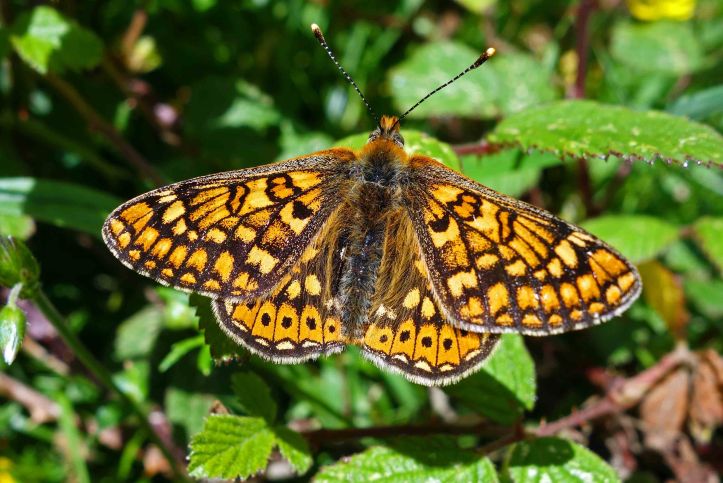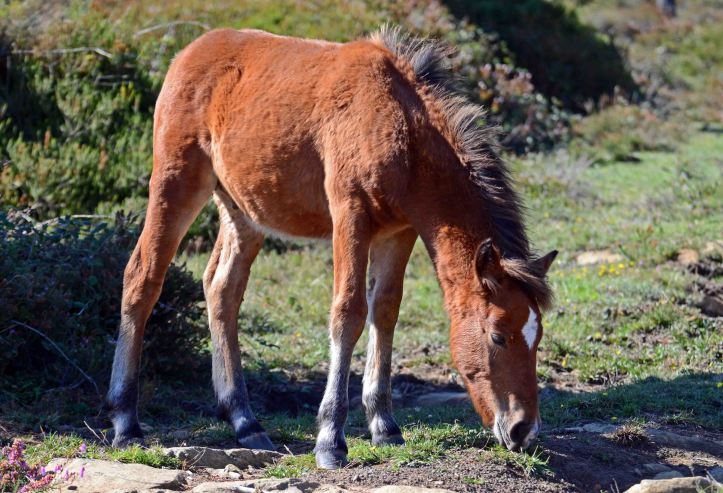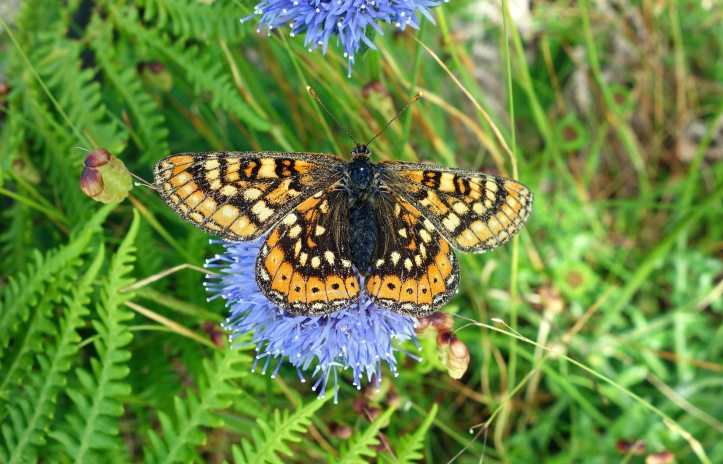
In my experience, the Marsh Fritillary, Euphydryas aurinia, is relatively common in Galicia (NW Spain) – where I took these photographs – but is considered to be threatened in the UK, where it has declined markedly in recent years, particularly over much of eastern England and Scotland (1). Despite that, the UK and Spain are considered to constitute strongholds for this species in Europe. It is said to prefer damp heathy grasslands, but can be found wherever the preferred larval food plant – Devil’s-bit scabious – occurs. It tends to occur in a series of small habitat patches less than 2 ha in size – which constitute a series of metapopulations. These small subpopulations fluctuate – i.e. die out and reform – from year to year, but the overall metapopulation usually persists. If colonies become too isolated however, as a result of changes in farming practices (agricultural intensification and loss of hedge rows) for example, then the overall population is in danger of dying out. The metapopulation becomes too fragmented and isolated to withstand the vagaries of environmental variability (and parasitism), and cannot persist in the long run. But the exact size and number of meta-patches needed to sustain a population are not known precisely and probably differ from place to place. Grazing by cattle and horses is said to promote an open and uneven sward of grass, which favours the host plant and hence the butterfly. This might be one reason why Galicia in Spain appears to be such a good habitat for this species, as there are many small, naturally managed farms and small holdings with horses and cattle present. In more central parts of Spain, large numbers of this butterfly are favoured by traditional agriculture and extensive grazing by cattle and goats (2).

Marsh fritillary larvae feed on Devil’s bit scabious (Succisa pratensis) and a variety of of other plants, depending on habitat and subspecies, including Small scabious (Scabiosa colombaria), Field scabious (Knautia arvensis), teasels (Dipsacus spp.) and Gentians (G. punctata, G. lutea). In one spot – close to Cabo de Bares in Galicia – where there were quite a lot of Euphydryas aurinia butterflies flying around in mid-June, they seemed to be associated with Sheep’s bit scabious, Jasione montana. Certainly the adults were landing on and nectar-feeding from these flowers, although whether the larvae fed on them as host plants, I don’t know. I am tempted to think that they did, given the abundance of both butterflies and flowers of this species.

The Marsh Fritillary butterfly has a very widespread distribution, stretching right across the Old World from Ireland to China. It is a very variable species with at least 34 subspecies recorded across this region. Presumably, there are healthy populations in many different places in Asia where traditional agricultural practices result in the maintainance of habitats suitable for this butterfly. Nevertheless, even in regions such as the Iberian Peninsula where it is doing reasonable well, changes resulting in a more ‘fragmented and monotonous landscape’ threaten this and other species with local extinction (3). Conservation management has identified the particular mix of factors – such as sward height and stock grazing density – that encourage the persistence of this species in threatened sites. But traditional agriculture, with mixed farming and grazing by horses, cattle and goats, appear to maintain this species (and no doubt many other such as bumblebees and other butterflies) without the need for conservation management.
1) Dr Martin Gaywood. Scottish Natural Heritage Information and Advisory Note Number 9. http://www.snh.org.uk/publications/on-line/advisorynotes/9/9.htm
2) Munguira, Miguel L., et al. (1997). Use of space and resources in a Mediterranean population of the butterfly Euphydryas aurinia. Acta Oecologica 18(5), 597-612.
3) Junker, Marius, and Thomas Schmitt. “Demography, dispersal and movement pattern of Euphydryas aurinia (Lepidoptera: Nymphalidae) at the Iberian Peninsula: an alarming example in an increasingly fragmented landscape?.” Journal of insect conservation 14.3 (2010): 237-246.
I found this article very interesting, we are not experts by any means but are interested in the Marsh fritillary as we seem to have a large colony of these lovely butterflies at our holiday home in southern Spain and would like to obtain advice in what, if anything, we should be doing to help manage the site.
Thank-you very much. I am not sure how to manage them! Probably just keep things a bit wild and let their host plant grow (Succisa pratensis or Devil’s-bit Scabious). Presumably there are a lot of these lovely blue flowers at your home? But it does feed on other things apparently, and there are different subspecies of the butterfly, so the southern Spanish one may have a different dialect to the one in Galcia! Best regards, Ray
[…] aurinia, appears to be thriving in this area, as well as others in Galicia, as I have blogged about before. This species can be found in a range of very different habitats across Europe, from raised bogs to […]